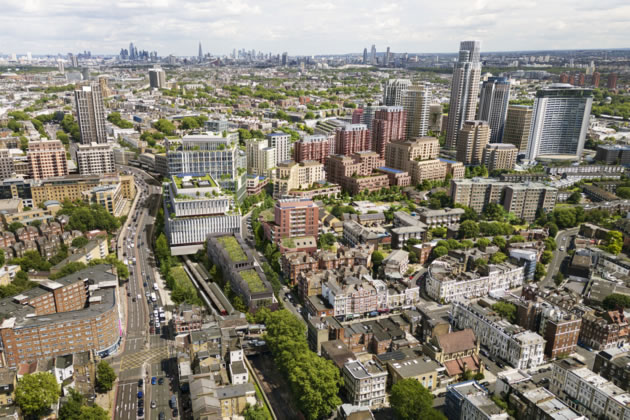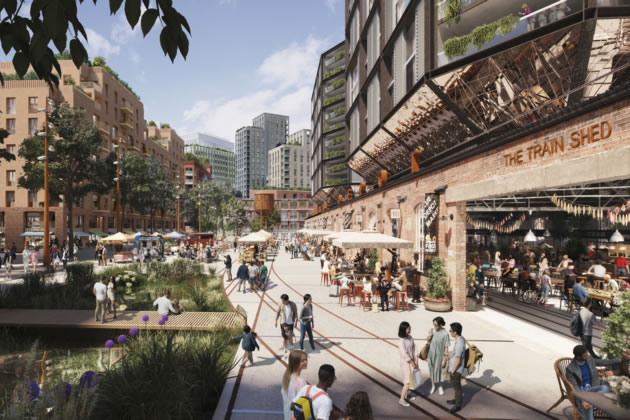Over 400 Objections Made to Earls Court Development
Proposal which would see 4,000 flats built also has support in the area

A visualisation of an aerial view of the Earl's Court development. Picture: ECDC
January 14, 2025
The proposal for the major development in Earl’s Court has received more than 400 objections. Residents and amenity societies across Kensington & Chelsea and Hammersmith & Fulham cited concerns about the impact of building 4,000 new flats on local infrastructure and transport links.
Some 345 letters of objection were sent to Kensington & Chelsea Council while 57 were sent to Hammersmith & Fulham, the two local authorities responsible for approving the scheme. The hybrid application was open to public consultation from September to late November, though Hammersmith and Fulham Council said they would continue to accept comments up until a decision had been made on the application.
The scheme, which is being proposed by the developer, Earls Court Development Company (ECDC), also received 157 letters of support. Among the issues raised by residents was a proposal to install a new cycle lane along Warwick Road.
One resident wrote, “I live on the junction of this road and Nevern Square and believe me, the traffic already as it is needs to be seen to be believed.” They added, “Buses hardly move, in fact people hop off the bus here and walk, having to cross the very fast dangerous A road, thinking it’s quicker. What about ambulances that use this road too? I love cycling myself but I strongly object to adding this lane to one of the most contested thoroughfares in London.”
Another wrote, “Wow whose brain thought that having a cycle [lane] would not cause more congestion on Warwick Road? Living in Earl’s Court Square for over 30 years, my only access is on Warwick Road. Sometimes [it] takes me 10 minutes from Earl’s Court road to the square because of congested 3 lanes. This is ludicrous.”
A third said the development would ‘overwhelm’ an already dense neighbourhood and its infrastructure, such as roads, Tube station and sewerage network and lead to a loss of privacy. They wrote, “The massive structures would severely impact existing residents through loss of daylight, creation of wind tunnels, and loss of privacy… I urge you to require revised plans with significantly reduced building heights and fewer units that respect our local context.”
A group of societies, including the Kensington Society and the London Forum, also wrote in, opposing the development. They claimed the large increase in homes would result in high service charges and over-population. They too said the new buildings would lead to a significant loss of natural daylight for residents of Philbeach Gardens, Eardley Crescent, Lillie Road, West Kensington and Gibbs Green estates and the West Cromwell Road.

A visualisation showing a piazza in the Earl's Court development. Picture: ECDC
Rebekah Paczek, Director of Public Affairs and Community Relations with ECDC, said the company’s masterplan had been through numerous iterations after receiving community feedback. She said the development would deliver 20 acres of public realm and open space including a 4.5-acre urban park and community gardens.
She also said cultural venues and pop-up spaces being built would bring the site to life along with jobs and workspace and create ‘an Earl’s Court for everyone’. She said the site would consist of a zero-carbon energy network and a comprehensive water management system.
That sentiment was shared by supporters. One said, “Earl’s Court is rundown and in desperate need of these new buildings and I fully support them.” Another said: “London is in the midst of a housing crisis and it is ridiculous for a major site like that at Earl’s Court not to be developed.”
A third said it would make Earl’s Court a more pleasant place to live. The plans have also received the support from local charities and businesses groups. Abdi Aden, Manager and Youth Worker at Earl’s Court Youth Club, said the development could provide hundreds of affordable homes.
He said, “This will provide many new opportunities for our local young people. It is vital that the local community continues to benefit from the economic growth, employability opportunities, and cultural enrichment that ECDC has already brought to the area. I urge both councils to approve this proposal, recognising the significant benefits it will bring to the local communities and its alignment with the broader regeneration goals for the area.”
The masterplan for the 40-acre former Exhibition Centre site was first revealed by ECDC in early 2023 after two years of planning. If approved, the first phase will consist of 1,000 homes, a cultural centre, workspace and 20 acres of public realm.
ECDC says it will open up the site ‘for the first time in 150 years’, and lay the groundwork for the creation of a new neighbourhood with homes, leisure facilities and more. A total of 4,000 flats are expected to be built once the development is complete, with 35per cent being classed as affordable, which is still below the council’s own affordable housing targets on new sites of 50 per cent.
Kensington and Chelsea councillor and Lead Member for Planning and Public Realm, Cem Kemahli, said he was ‘very keen’ to see a development that helps breath life back into the area. He told the Local Democracy Reporting Service (LDRS) the site represents a major opportunity to building much-needed homes and revive a cultural landmark.
He said, “The planning process is under way and I see it as positive that so many people care about their community and have given their views on the application to help us get the best possible development in Earl’s Court. Many of their objections include positive improvements that could be incorporated and our officers will now fully review the application and all the representations that we had in the consultation.”
Cllr Kemahli added, “We must always remember that the people who may one day live in and therefore support this development are unlikely to write in on a planning application years before they get the keys to their new home.”
The ECDC’s Ms Paczek said, “We are in the midst of an acute, and well-documented, housing crisis. Earl’s Court is a 44-acre, largely derelict urban brownfield site in Central London, with three Tube stations and an Overground train line. If we cannot build the homes London desperately needs here, in a development which has been masterplanned in consultation with the local community, using a landscape-led approach, with a team of carefully chosen world class architects and, crucially, giving a voice to those who are usually excluded from the planning process – young people, those with disabilities and those from under-represented communities – where can homes be built?
“Our role, and the role of those responsible for creating the homes and communities on which London depends, is to balance the needs of future generations with the needs and aspirations of existing communities – we have consistently worked to get that balance right. Ten years after the Exhibition Centres closed and left the site unused, and five years after we acquired it, we are focused on bringing the site back to life, opening up access to all and delivering a new piece of city. The exciting nature of London has always been its ability to evolve and transform, Earl’s Court will be the next part of the story of London.”
Ben Lynch – Local Democracy Reporter